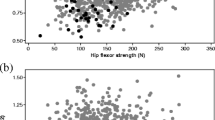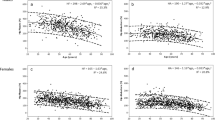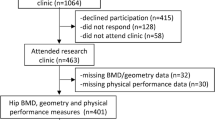Abstract
Dual energy x-ray absorptiometry (DEXA) offers the possibility of assessing regional soft tissue composition, i.e. lean mass (LM) and fat mass : LM may be considered a measure of muscle mass. We examined age-related differences in LM, percentage fat (%fat) and muscle strength in 100 healthy non-athletic women aged 18–87 years. Relationships between muscle strength and leg LM in 20 elite female weight lifters and in 18 inactive women with previous hip fractures were also studied. The LM and %fat of the whole body, trunk, arms and legs were derived from a whole body DEXA scan. Isokinetic knee extensor strength (KES) and flexor strength (KFS) at 30° · s–1 were assessed using an isokinetic dynamometer. The women aged 71–87 years had 35% lower KES and KFS than the women aged 18–40 years (P < 0.0001). Differences in LM were less pronounced. The LM of the legs, for instance, was 15% lower in the old than in the young women (P < 0.0001). In a multiple regression analysis with age, body mass, height and leg LM or KES as independent variables and KES or leg LM as the dependent variable, age was the most important predictor of KES (r partial = −0.74, P < 0.0001). The same applied to KFS. Body mass, not age, was the most important predictor of leg LM (r partial = 0.65, P < 0.0001) and of LM at all other measurement sites. The LM measured at different regions decreased equally with increasing age. The KES:leg LM ratio was negatively correlated with age (r = −0.70, P < 0.0001). The weight lifters had significantly higher KES:leg LM ratios than age-matched controls (+12%, P < 0.0001) and vice versa for the women with previous hip fractures (–36%, P < 0.0001). In conclusion, from our study it would seem that in healthy nonathletic women, age is a more important determinant of muscle strength than is LM as measured by DEXA. Muscle strengthening exercises and inactivity seem to have a considerably stronger influence on muscle strength than on LM.
Similar content being viewed by others
Author information
Authors and Affiliations
Additional information
Accepted: 27 August 1996
Rights and permissions
About this article
Cite this article
Madsen, O., Lauridsen, U., Hartkopp, A. et al. Muscle strength and soft tissue composition as measured by dual energy x-ray absorptiometry in women aged 18–87 years. Eur J Appl Physiol 75, 239–245 (1997). https://doi.org/10.1007/s004210050154
Issue Date:
DOI: https://doi.org/10.1007/s004210050154




